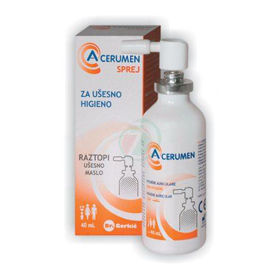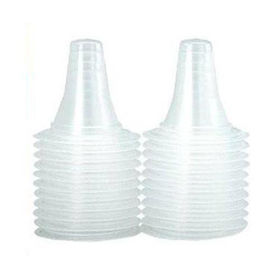Are your ears full of earwax? On a smaller scale, ear wax is welcome; occasionally, a few drops of cleaning solution are enough to clean the ear.
EAR CLEANING: Ear Cleaning, in General, | How do we clean the ear properly? | Hearing problems | Symptoms | Consult a doctor | Causes | Diagnostics | Treatment | Conventional Medicine | Alternative Modes | Questions and Answers | Sources/references
One of the most common causes of temporary hearing loss is earwax buildup. You can clean the butter without damaging the ear with this simple method:
Heat the hydrogen peroxide by submerging the container in hot water for a few minutes. Tilt your head to the side and pour warm liquid into the blocked ear with a dropper. Leave it there for three minutes. Then tilt your head to the other side, and let the hydrogen peroxide drain onto the towel. The earwax is now soft enough to remove with a cotton swab. You can repeat the process if necessary.
If the ear wax is rigid and does not soften with hydrogen peroxide, try softening it by putting 3 to 4 drops of castor oil or glycerin in the ear several times. If the earwax is firmly lodged, your ear will need to be washed by a doctor.
How do we clean the ear properly?
If your earwax problem is not very serious, but you feel there is too much buildup, you can gently clean the outside of your ears. Use a cosmetic washcloth. You can also try baby oil, mineral oil, or glycerin to soften the earwax as much as possible. You can also consider an earwax removal kit.
Video content: how to clean your ears the right way?

Do not use pointed objects other than cotton buds to clean your ears. Studies show that doing this is not effective and can even cause injuries.
Your ear canal usually does not need cleaning.
Video content: how to easily remove earwax - earplug with a syringe?

But suppose too much earwax builds up and starts to cause uncomfortable symptoms or prevents your doctor from properly examining your ear. In that case, you may have cerumen, meaning earwax has filled your ear canal.
Hearing problems
Many people - in the USA, for example, as many as 28 million, more than 10 percent of the population, have hearing problems that are severe enough to interfere with understanding speech and communicating with others. Quite a few people cannot hear, and we consider them deaf. With age, the probability of hearing problems increases: more than a third of people over 75 years of age are hard of hearing, so they are often desperate and lonely.
One form of age-related hearing loss - presbycusis - usually starts between 40 and 50 and steadily worsens. Patients cannot hear high frequencies, so it is tough to understand women and children who speak at a higher frequency than men. Presbycusis affects men more often and more severely than women.
Hearing problems are less common in children, but if left untreated, they can majorly impact how a child learns and interacts with peers. About 1 in 1,000 newborns has such a hearing impairment that it interferes with learning to speak.
Video content: 3 types of hearing loss.

Doctors divide hearing loss into two main categories. Conductive hearing loss occurs when the transmission of sound waves from the outer to the inner ear is disturbed. Sensorineural hearing loss is caused by damage to the inner ear or the nerves that carry sound signals from the ear to the brain. Although the sound can reach the inner ear, we do not perceive it because the message is not correctly transmitted to the brain. A mixed type of hearing loss is also possible.
Symptoms
People repeatedly don't notice their hearing problems until a relative or friend points them out.
Symptoms can be:
- the patient cannot hear in one or both ears or cannot distinguish some or all sounds;
- the patient has difficulty understanding speech when many people are talking in the background;
- He should set the volume on the TV or radio louder than most people are comfortable with.
Hearing problems are sometimes accompanied by dizziness, pain in the ears, discharge or bleeding from the ear canal, ringing in the ears, or, in rare cases, paralysis of the facial muscles.
CONSULT YOUR DOCTOR IF:
- Notice any hearing problems; the doctor must assess the condition in time, as early treatment can prevent permanent hearing impairment.
- You suddenly stop hearing in one or both ears; this may indicate a severe drug reaction, an auditory nerve tumor, or a neurological problem. Seek medical attention as soon as possible.
- Your hearing worsens, and you have purulent or liquid discharge from the ear canal; the cause may be an ear infection or a perforated eardrum.
- Hearing loss is accompanied by dizziness and nausea; these may be signs of otitis media, Meniere's disease, or another condition that requires medical attention.
CAUSES
Hearing loss, partial or total, is not a disease but a symptom of an underlying disease. A wide variety of medical conditions can cause hearing problems. Common causes of conductive hearing loss include excessive earwax, ear infections, and a ruptured or punctured eardrum. Even benign cysts, tumors, and foreign bodies in the ear canal, e.g., insects or pieces of children's toys, hinder the transmission of sound to the inner ear. In addition, many hereditary diseases cause conductive hearing loss. Among these, the most common is otosclerosis, a degenerative disease of the small bones of the middle ear. About 1% of the population has otosclerosis, usually in both ears.
Also, in sensorineural hearing loss, especially in children, heredity is a common, if not the main, cause. Experts estimate that in half of the children who are completely deaf, the cause is inherited. Hereditary predisposition is also an essential factor in the development of presbycusis. In these patients, thousands of tiny hair cells located in the cochlea, the spiral-shaped cavity of the inner ear, slowly die. Sound is difficult or impossible to perceive without the hairs involved in converting sound vibrations into nerve impulses that travel to the brain.
Video content: causes of sudden hearing loss.

The sensitive hair cells of the cochlea can also be destroyed by prolonged exposure to loud noise, especially high-frequency noise, and lead to partial or complete sensorineural hearing loss. Workers exposed to loud noise at work, e.g., carpenters, construction workers, rock musicians, and people involved in hunting or motorsports.
Many infectious diseases - the most important being shingles, meningitis, syphilis, and cytomegalovirus infection - are associated with sensorineural hearing loss. In addition, if a woman contracts rubella during pregnancy, the child is more likely to have permanent hearing loss. Irreversible damage to hearing mechanisms also occurs if the child is exposed to a lack of oxygen during birth.
Other causes of sensorineural hearing loss include Meniere's disease, brain or auditory nerve tumors, diabetes, and vascular changes that can cause stroke, such as high blood pressure and atherosclerosis. Permanent inner ear damage is also caused by high acetylsalicylic acid, quinine, certain antibiotics, and many diuretics used to treat high blood pressure. Patients with multiple sclerosis or other neurological diseases are also prone to sensorineural hearing disorders. In addition, blunt or open injury to the ear can cause permanent hearing loss.
DIAGNOSTIC PROCEDURES
The doctor will first thoroughly examine you, especially your ears. In this way, he will determine whether the cause of the hearing problems is a medical condition that can be treated. He may also perform some simple hearing tests. If he does not explain the cause of your problems, he may refer you to an otologist or otorhinolaryngologist (both specialists in ear diseases) for detailed hearing tests.
The most common of these examinations is audiometry, in which first they measure how well you hear sounds transmitted through the ear (to determine conductive hearing loss) and then how well you hear sounds through the bones of the skull (to determine sensorineural hearing loss). They lock you in a soundproof room and send you through headphones a series of sounds of increasing and decreasing volume, from low to high frequencies. The specialist may also recommend a neurological examination and imaging with MRS or CT to rule out tumors.
HEALING
In conductive hearing loss, hearing is restored chiefly after treating the cause. In the case of sensorineural hearing loss, the hearing loss is usually permanent.
Treatment can sometimes stop or slow the progression of hearing loss, and hearing quality rarely returns to pre-impairment levels.
CONVENTIONAL MEDICINE
Treatment of hearing loss depends on the cause of its occurrence. If the cause is earwax buildup, your doctor will flush your ear canals. If you have an ear infection, he will prescribe antibiotics or ear drops containing an antibiotic and hydrocortisone to relieve the itching. Suppose the fluid accumulated during otitis media does not drain on its own. In that case, the doctor performs a myringotomy, making a small incision in the eardrum and sucking out the fluid.
Recurrent otitis media, allergies, frequent respiratory infections, and enlarged pharynx can cause blockage of the Eustachian tube, which connects the pharynx to the middle ear. Therefore, the pressure in the middle ear is reduced, the eardrum is pulled inward, and fluid is secreted into the middle ear cavity. This condition is quite common in young children. Your child's doctor may recommend surgery; he inserts a thin plastic tube through the eardrum to equalize the pressure in the middle ear. The tube remains in the eardrum for six months or more while the Eustachian tube is repaired.
Recurrent otitis media can also damage other structures in the middle ear that need to be surgically repaired or replaced to restore hearing to normal. A middle ear infection can, e.g., in rare cases, spread to the part of the skull bones behind the ear called the chin (mastoid process). A special operation called a mastoidectomy is required, in which the damaged bone is removed, and hearing is restored.
If the cause of your hearing loss is a punctured eardrum, your doctor will likely prescribe an antibiotic to prevent the development of a middle ear infection. The damaged eardrum is sometimes covered with a plastic cloth to protect it while it heals. If the eardrum does not respond to such treatment within three months, your doctor may suggest a minor operation in which the hole in the eardrum is covered with a small piece of tissue obtained mainly from a vein graft. This intervention is usually successful, and hearing becomes normal.
Video content: Treatment of hearing loss and tinnitus using stem cells

If the cause of hearing loss is otosclerosis, your doctor may recommend a stapedectomy, an operation in which the damaged ossicles of the middle ear are replaced with metal substitutes. Research has shown that hearing improves in 90% of patients after stapedectomy. However, the operation is risky: 2 to 5% of people who undergo the operation become completely deaf in the affected ear after the operation.
Since the nerves or the inner ear are damaged in sensorineural hearing loss, it cannot be successfully treated with drugs or surgery. However, you can sometimes, with immediate medical
care, prevent the development of sensorineural hearing loss. Sudden hearing loss due to a blood clot in the artery that feeds the ear is treated with anticoagulants. The doctor sometimes also prescribes a vasodilator, which widens the blood vessels and thus allows the clot to float away. If you receive these medicines within 24 hours of the first signs of hearing loss, and if the hearing loss is only partial, a hearing will likely be fully restored.
The only treatment for presbycusis and other forms of permanent hearing loss is a hearing aid. This device contains a small microphone and an amplifier to increase the sound volume electrically. A small battery powers the hearing aid. Some hearing aids are placed behind the ear, but more common are compact models placed in the ear canal.
A hearing aid will not correct your hearing loss but will allow you to hear better. Consult a qualified professional. Your doctor may be able to recommend a reputable audiologist or hearing aid retailer who can introduce and test different hearing aid models. They will make a mold of your outer ear so that the hearing aid fits snugly in your ear and works flawlessly. Allow yourself some time but get used to the device. However, if it is uncomfortable or does not improve hearing, replace it or return it to the dealer. A reputable hearing aid dealer must give you a trial period before making a final purchase.
Video content: how does a hearing aid work?

Some rare people who are entirely deaf have been helped by an operation known as a cochlear implant. Fragile wires called electrodes are implanted in the inner ear's cochlea, a spiral-shaped area. One end of each electrode is connected to the auditory nerve, the other to a small battery-powered speech processor and microphone worn outside the ear. A microphone and processor convert the sound into electrical impulses that travel through the electrodes and stimulate the auditory nerve. This then sends impulses to the brain. Although the operation is promising, it has had limited success so far. Post-surgery patients report that the device improves their lip-reading skills but does not allow them to understand speech without lip-reading.
ALTERNATIVE MODES
Like conventional treatments, alternative treatments primarily aim for underlying diseases that can cause temporary hearing loss.
ACUPUNCTURE
Acupuncture cannot improve hearing loss caused by permanent damage to the nerves or hearing mechanisms in the ear. However, it can help patients better distinguish the sounds they still hear. Acupuncture also treats ear infections that cause temporary hearing problems. Consult an acupuncture specialist.
HERBS
Many herbs can be used to cure ear infections that cause hearing loss. Garlic (Allium sativum), proven to work as a natural antibiotic, is very effective. Drop 1 to 3 drops of garlic oil into the ear thrice daily. You can buy the oil at a herbal shop or make it yourself.
Frequently Asked Questions and Answers
What are the best ways to clean your ears?
It is best to use a washcloth to clean the ears. You can also try baby oil, mineral oil, or glycerin to soften the earwax as much as possible. You can also consider an earwax removal kit. Do not use small or pointed objects to clean your ears, except cotton swabs if necessary[1].
Is it safe to clean the inside of the ears?
According to the American Academy of Otolaryngology, cleaning the ears is necessary as long as they arworkroperly. For most people, however, earwax does not cause any particular problems and, consequently, does not need to be removed[2].
How often should I clean my ears?
Cleaning the ear canal too often can do more harm than good, as by doing so, you remove the delicate protective lining, leaving an open path for bacteria to enter and increase in that area. Experts recommend only cleaning your ears every two to four weeks[3].
Is it acceptable to clean your ear with your finger?
Apart from the risk of damaging the ear canal and, among other things, pushing earwax back up the ear canal, sticking your finger in your ear is a mistake, as your fingernails usually harbor many microscopic bacteria that could cause an infection. Especially if you are a diabetic or suffer from pre-diabetes, you are consequently at a higher risk of infection[4].
Sources and references
Source: Family Health Guide. Conventional and alternative treatment, Dr. Jaro Lajovic, Publishing House Mladinska knjiga
1. How to Clean Your Ears - https://www.webmd.com
2. Time to Quit Removing Wax from Our Ears - https://www.pennmedicine.org
3. The Proper Way to Clean Your Ears - https://peninsulahearing.com
4. 6 Mistakes Your Ears Want You To Stop Making - https://www.prevention.com













